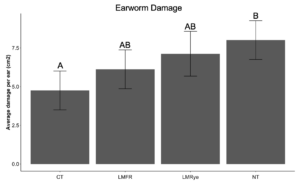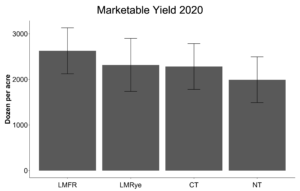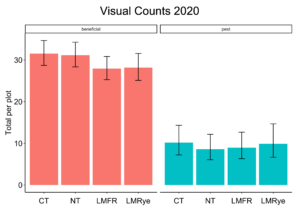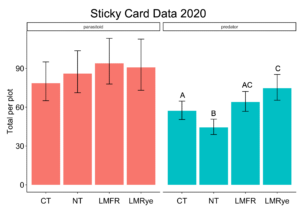Final report for GNE19-224
Project Information
This project was conducted primarily over the 2020 growing season in order to address the need for non-chemical insect pest control methods in sweet corn production by investigating the potential for cover crop residues and living mulches to increase insect natural enemy abundance, consequently reducing pest numbers and associated crop damage. Visual assessments, sticky cards and pitfall traps will be used to determine the diversity of natural enemies present, and sentinel corn borer and earworm egg masses will be placed in the field and assessed for predation/parasitism. Additionally, corn earworm pre-pupae will be tethered and exposed to ground predators in all treatments to determine predation mortality. Crop damage and overall yield will also be assessed in each treatment. Results were presented at on-farm tour events, extension meetings throughout the following fall/winter seasons and at at least one scientific conference. Results of similar research indicate greater natural enemy abundance and decreased pest herbivores in crop fields with greater plant diversity. Results of this experiment failed to detect many significant differences, with greater predator abundance detected in only one of two living mulch treatments compared to the conventional control treatment. However, a lack of yield difference highlights the feasibility of growing sweet corn in combination with a red clover living mulch. This can offer significant weed suppression benefits (investigated in another aspect of this experiment) even if insect pest control remains reliant on insecticides or genetically modified varieties.
The overarching project goal is to improve the biological control services provided by ground and foliar inhabiting natural enemies in sweet corn plantings.
My primary research objectives are to assess the effects of growing sweet corn with an interplanted living mulch and cover crop residues on:
1) the abundance of natural enemies present,
2) rates of predation and/or parasitism of corn earworm and European corn borer egg masses,
3) rates of insect damage at crop harvest
4) crop yield.
The purpose of this project is to investigate the ability of cover crop residues and living mulch to enhance natural enemy abundance to suppress the corn earworm and the European corn borer and reduce ear damage. More specifically, I will investigate effects of red clover living mulch and crimson clover/rye residues on predation and parasitism of the immature stages of the corn earworm and European corn borer, and examine treatment impact on corn earworm adult emergence.
The corn earworm is a polyphagous lepidopteran pest of several field and vegetable crops, and is one of the most devastating and difficult to control insect pests in the United States. Up to 50% losses in sweet corn have been reported as a result of this pest. The European corn borer, though largely controlled in many areas of the United States with genetically modified (GMO) corn varieties, still has the potential to cause significant damage to non-GMO sweet corn cultivars. Thus, organic farmers and others not using GMO sweet corn must depend primarily on insecticide sprays. However, resistance problems may reduce the period that insecticides and GMO cultivars are effective. Additionally, both pests are difficult to control via foliar insecticides due to the short period of vulnerability before they are protected inside the corn plant. This suggests that growers, especially organic producers, can benefit from more sustainable management options.
Living mulches, which are cover crops grown alongside the main crop throughout the growing season, and cover crop residues are increasingly used to suppress weeds in agricultural production. However, limited research has been conducted to evaluate their impact on insects and other arthropods in specialty crops. Previous research investigating the impact of no-till production on corn earworm prepupal search behavior and subsequent site selection for pupation indicates a preference for loose, tilled soils over smooth, compacted surfaces associated with no-till production. Studies determined H. zea pupae spent a significantly greater amount of time and traveled greater distances searching for a suitable pupation location in no-till compared to conventionally tilled fields. This increased search time extends the period that larvae are vulnerable to predation by ground-dwelling arthropods, many of which are more abundant in more diverse habitats. This suggests that integrating cover crops into sweet corn systems should result in greater pre-pupal predation and a subsequent reduction in H. zea adult emergence. This could have important consequences on numbers of adult moths dispersing to other crops later in the growing season.
Foliar searching natural enemies may be greater in living mulch systems, often resulting in reduced insect pest populations. Thus increased mortality due to natural enemies could occur in the foliage and at soil level. However, few studies have investigated the impact of habitat diversification on H. zea infestation rates in sweet corn; and to my knowledge, no studies have examined impacts of cover crop residues on H. zea or O. nubilalis mortality from natural enemies; and how this affects ear damage and yield. Thus, this project will contribute to the sparse body of knowledge related to the impact of habitat diversification on economically important sweet corn pests and provide growers a more sustainable and environmentally friendly option.
Research
Cover crop treatments were established in early September 2019. The four treatments are: NT (no till), CT (conventional till), LMFR (living mulch + forage radish) and LMRye (living mulch + rye). In the NT and CT treatments, a mixture of crimson clover, forage radish and rye cover crops were planted. In the LMFR treatment, alternating rows of red clover and forage radish were planted, and in the LMRye treatment, alternating rows of red clover and rye were planted. All cover crops were planted on September 5, 2020 at 6 inch row spacing. Additional overhead irrigation was required after ~ 2 weeks due to excessively dry conditions. In Spring, (Mary 25, 2020) when the cereal rye reached anthesis, the cover crops were terminated. The NT treatment was terminated using a roller to create a thick barrier of cover crop residue. The CT treatment was mowed and disked to create a bare ground control treatment. The LMFR and LMRye treatments were rolled to terminate any remaining forage radish as well as the cereal rye respectively. Immediately following cover crop termination, sweet corn (variety: Providence) was planted in each treatment at 30 inch row spacing, resulting in sweet corn rows centered between the rows of red clover living mulch in the LMFR and LMRye treatments.
Beginning four weeks after planting, pest and beneficial insects were monitored via visual counts, yellow sticky cards and pitfall traps. Weekly visual counts were performed by visually inspecting the entire surface of twenty corn plants per plot and recording any pest or beneficial insects present. To assess aerial insects within each treatment, two yellow sticks cards per plot were set during four sweet corn growth stages (V5, V13, R1, R3) and remained in the field for one week. Finally, to assess epigeal insect communities, four pitfall traps per plot were set up such that two traps were within the sweet corn row and two were between sweet corn rows, in the red clover in LMFR and LMRye treatment plots. Two sampling dates corresponding to the V9 and R2 sweet corn stages were planned. However, due to heavy rains, pitfall trap catches were lost for the second date, resulting in pitfall samples from only the V9 growth stage.
To assess treatment effects on rates of pest predation and/or parasitism, ten corn earmworm and ten European corn borer egg masses per plot were deployed weekly beginning in mid-June. Using insect pins, European corn borer egg masses were attached to the undersurface of a leaf, while corn earworm eggs were attached to the husk tip around the corn silk. Egg masses were collected after three days, evaluated for predation, then placed in gel caps and monitored for parasitoid emergence. An experiment testing predation of earworm prepupae was planned. However, due to difficulties associated with the COVID-19 pandemic, this experiment was postponed and performed in the 2021 growing season.
Because this study exists within a larger weed management experiment, treatment plots were divided into two subplots, one which received an at-planting application of residual herbicide and the other which did not. Herbicide application is assumed to have no effect on insect data collected for this experiment since the application occurred before sweet corn seed germination. However, impacts on crop yield are possible. Therefore, yield data was collected and analyzed separately for each subplot. All marketable ears were harvested from the center 6.1 meters of the center four rows of each subplot, weighed, and rated for corn earworm, sap beetle and stink bug damage. Earworm damage was measured as square centimeters of damage per ear. Sap beetle and stink bug damage was measured as number of damaged kernels.
Crop Yield
Similar numbers of marketable sweet corn ears were harvested from all subplots, resulting in no significant differences in yield between any treatment (Figure 1). Marketable ears were classified based on adequate ear size and pollination.
Figure 1. Total marketable ears harvested by treatment.
Harvest Damage
Damage ratings indicated significantly greater earworm damage in sweet corn ears harvested from the NT treatment compared to the CT control treatment. No significant differences in damage were found in either living mulch treatment compared to the control (Figure 2). No differences in corn borer, sap beetle, or stink bug damage were detected between treatments.

Predation and Natural Enemy Abundance
Visual counts of all insects performed across the full sweet corn growing season did not indicate any differences in overall abundance between any treatments for both natural enemy and pest species (Figure 3). Yellow sticky traps further did not detect differences among treatments in parasitoid wasp species abundance. However, lower predator abundance was detected in the NT treatment as well as greater predator abundance in the LMRye treatment compared to the control treatment (Figure 4). Predation trials of corn earworm prepupae indicated no significant differences in predation by ground predators among any treatment on any sampling date. Predation and parasitism trials of sentinel egg masses similarly indicated no significant differences among treatments.
Figure 3. Total counts of beneficial (left) and pest (right) species performed across the full sweet corn growing season.
Figure 4. Total counts of parasitoids (left) and predators (right) detected on yellow sticks traps throughout the sweet corn growing season.
Overall, results of this experiment indicate growing sweet corn in combination with red clover living mulch does not result in a reduction in total yield, indicating competition between the living mulch and the sweet corn crop did not occur. Greater pest damage was detected at harvest in the NT treatment compared to the CT control, possibly resulting from lower insect predator abundance, as was detected on yellow sticky cards, or delayed silking resulting from slower seedling emergence in spring. Delayed silking can potentially result in ears that are more attractive to ovipositing earworm adults at a time of greater moth pressure. No difference in harvest damage was detected between either living mulch treatment and the CT control. As such, there appear to be no direct drawbacks associated with incorporating either living mulch system into sweet corn production. Although insect measurements did not yield the expected significant results, this may be due to the high landscape-level diversity associated with the farming region where the experiment took place. Non-crop areas and landscape heterogeneity have been associated with a greater abundance of insect natural enemies, supporting populations that later move into nearby cropping systems. Higher overall natural enemy populations combined with relatively small plot sizes may have made treatment-level differences more difficult to detect. Results of a weed experiment concurrently being conducted within this experiment indicated that the red clover living mulch suppressed weeds as well as the CT treatment when paired with conventional herbicides. Therefore, although no direct benefits on natural enemy abundance or earworm pest control were observed, incorporating red clover living mulch into sweet corn production does result in excellent weed suppression and reduced herbicide use without yield-reducing competition. As such, this system can directly benefit both conventional and organic small-scale producers when used in combination with additional insect pest control measures such as genetically modified corn varieties or targeted insecticide applications to sweet corn silks. Future research will need to determine if greater insect natural enemy abundance occurs in living mulch treatments when grown on a larger scale.
Education & Outreach Activities and Participation Summary
Participation Summary:
An on-farm demonstration/field tour was planned for the summer of 2020 to highlight any impacts of the different treatment combinations on sweet corn growth and insect damage. However, due to COVID restrictions, a virtual field tour was performed instead and made available on youtube. As of November 2021, the video has been viewed 242 times.
Participation in on-farm field tours/twilight meetings describing research activities and outcomes related to this project took place at:
- University of Maryland's Crops Twilight Tour took place on August 21, 2021 (attendance 72). A handout was created and distributed at this event to further describe experimental treatments and project objectives.
- Loudon Vegetable and Fruit Twilight Meeting on July 28, 2021 (attendance 18).
The following talks/presentations disseminating research related to this project occurred:
-
“Creating an ecofriendly pest suppression program in sweet corn”. Northeast Integrated Pest Management (IPM) Research Update Conference. Zoom Meeting, Northeast IPM Center. March 31, 2021.
-
A fortuitous partnership: The tale of winter cover crops and strip tillage crusade against pests. Cornell University New York State Integrated Pest Management Academic Seminar Series. March 18, 2021. (Attendance 31).
-
Yurchak, V.*, A.W Leslie, C.R.R. Hooks. 2021. “Using living mulch in reduced tillage sweet corn”. Mid-Atlantic Fruit and Vegetable Convention. Virtual. Feb. 9. (Poster Presentation)
-
“Red clover: a memoir of a zealous cover crop, its friends and their battle with crop pests.” Virginia Tech University, Department of Entomology Seminar Series. November 05, 2020. (Attendance 45)
Participation in the following workshops:
- Workshop Title: Beginning Farmers Training Program. Presentation Title: Using cover crops and minimum tillage practices to influence insect and weed pests in vegetables. Zoom meeting, Upper Marlboro, MD, April 01, 2021. Attendance 20
Only total attendance/views was recorded for all events, so the breakdown of farmers vs: agricultural educators/service providers reached is only an estimate (approximating ~ 20% of total attendance and online views were educators/service providers).
Project Outcomes
This project supports sustainable sweet corn production by identifying a successful living mulch system that does not require strip tillage or herbicides. The reduction in both chemicals and passes through the field with a tractor can likely save farmers significant amounts of money early in the growing season. Environmental benefits include potentially increased soil health associated with greater plant diversity in the living mulch treatments, as well as benefits resulting from reduced herbicide applications and tillage.
Overall knowledge gained from this experiment supports to integration of red clover living mulch into sweet corn production systems. A concurrent study identified excellent weed suppressive benefits associated with red clover living mulch, highlighting its ability to suppress weeds as well as conventional herbicides. A reduction in herbicide use can both save farmers money as well as reduce the overall chemical load being released into the environment. This study specifically highlighted the fact that red clover living mulch did not contribute to crop competition or increase levels of insect pest damage. Future research should investigate the use of red clover living mulch in sweet corn production on a greater scale to potentially detect more abundant populations of natural enemies. Additional studies are also investigating pollinator populations supported in this system, to determine the potential role of red clover for pollinator conservation.


